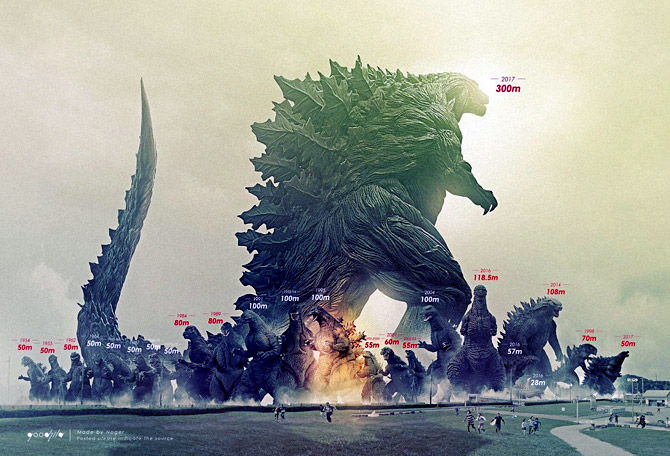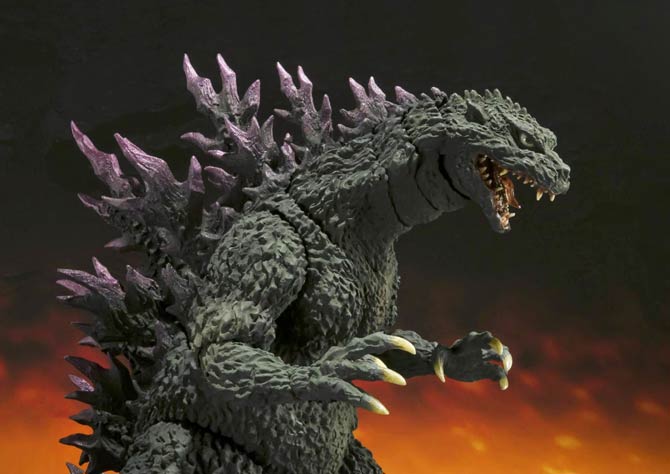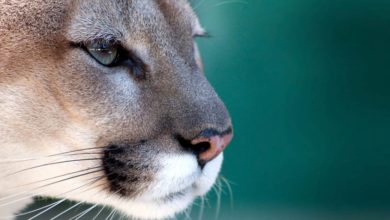Godzilla (Gojira)
Kaiju movies, or about great monsters, are one of the most famous creations of Japanese pop culture. Of course, Godzilla is in the lead among them. Probably everyone recognizes his name and image, even if he or she is not a fan of this type of film. Despite the passage of time, Godzilla’s popularity has not declined, as evidenced by the fact that more films with his participation are being made in Japan and America.
Since 1954, several dozen films, animated series, and comics starring Godzilla have been made. Their character and message changed, as did the image of the monster and its attitude towards people. For many years, Godzilla was played by an actor in a rubber costume – the first and most famous “Godzilla” was Haruo Nakajima. Today, the monster is computer-generated (animated), and has grown significantly, but out of respect for the prototype, the characteristic silhouette (and the roar) has remained virtually unchanged.

Where did the name Godzilla come from?
It should start with the fact that “Godzilla” is not an appellation, but a name. Of course, it comes from the Japanese. In the original, it reads “Gojira” and was created from a combination of words meaning gorilla (“gorira”) and whale (“kujira”) – originally the monster was supposed to be a cross between these animals. However, it was deemed to be too grotesque to appear credible as a formidable beast, so the design was changed. The name, however, remained, and in the distorted English version – “Godzilla” – it found its way into many languages around the world.

The genesis of Godzilla
Contemporary films about Godzilla are effective productions intended for a wide audience. The first film stands out against their background, as many scenes and the atmosphere bring to mind a serious anti-war drama. The creation of Godzilla is closely related to one of the most tragic episodes in the history of wars – the use of atomic bombs in Hiroshima and Nagasaki.
These raids caused trauma for the Japanese, unimaginable in our culture, which had never experienced the effects of the use of these weapons. This experience required an outlet, but the tragedy was a taboo subject in the Land of the Cherry Blossom, besides the censorship imposed by the Americans during the occupation of Japan made it impossible to say it directly.
In the spring of 1954, a coincidence happened that changed everything. Tomoyuki Tanaka, a film producer working for Toho, was returning from Indonesia, where the shooting of his latest film was cut short for financial reasons – at the same time the studio ordered him to shoot something else later that year.
Reflecting on the possible content of the work, during the flight, Tanaka read about the tragedy that happened to the crew of a fishing boat, which on March 1, 1954 was sailing near the area where nuclear weapons were tested. All sailors died of irradiation. Tanaka decided to make a movie about the use of nuclear weapons. As he could not say it directly, he decided to use the symbol.

Tanaka communicated with director Ishiro Honda. The choice was not accidental – in 1945, Honda was a soldier, he survived the tragic raids of American bombers and saw the effects of the nuclear attack on Hiroshima with his own eyes. Together, they decided that the metaphor for nuclear weapons would be a monster – huge and almost indestructible. The idea was so good that in 1933 “King Kong” was created, which proved that films about great beasts devastating cities can be a commercial and artistic success.
The direct inspiration for the creators, however, was not King Kong, but another film today considered to be the classic of the genre – “The Beast from 20,000 Fathoms” (1953). This film shows Americans forced to fight a monster somewhat similar to a crocodile, which has been awakened by a nuclear explosion and devastates New York. This film today belongs to the so-called Class “B” cinema, however, was quite successful and today many people consider it a classic of the genre.

However, Tanaka did not want his movie to be considered plagiarism, so the monster was supposed to look different. Initially, it was planned to cross a gorilla and a whale, later the monster was to receive a head in the shape of an atomic mushroom, and even take the form of a large octopus; however, it was deemed to look grotesque. Finally, Tanaka decided that it would be best to present the beast as a giant dinosaur, but not similar to known species.
It was supposed to be distorted (hence the growths on the back) and to bear scar-like marks on the skin – all of this was supposed to suggest the effects of using an atomic weapon.
The first Godzilla film was intended as a protest against war and nuclear weapons, so its mood is serious and at times tragic. The creators also wanted to awe the viewers. Ishiro Honda realized that people were most affected by the reactions of others. That is why, the film features characteristic scenes when we can watch people panicked and fleeing from a threat that the viewer can see only much later. There were also dramatic scenes, such as the touching farewell of a mother to her daughter in the last seconds before the monster’s attack.

The fate of Godzilla
The anti-war message and the perfect performance at that time made the film a success, so it was decided to use the monster in subsequent productions. Gradually, other beasts joined Godzilla, such as the great moth Mothra, the giant bird Rhône and finally the most famous enemy – the three-headed dragon Ghidorah. At the same time, the image of the monster changed – Godzilla often ceased to be a threat to humanity, but became its protector against other beasts, often directed by the will of aliens or terrestrial terrorists.
Godzilla in these films sometimes turned against humans, but this was due to the deliberate action of evil forces. As in the first original film, Godzilla was here a symbol of atomic energy, which can serve good or bad – depending on whose influence it is placed on.

The nature of the films has changed over time. While the first was a horror film with drama elements, the later ones moved towards “light” fantasy films, often with comedy elements, as they were ultimately intended to be family productions. Later, the creators moved away from this pattern to make them more attractive to adult audiences, but never did any Godzilla movie ever reach the level of the first work of 1954.
In films about Godzilla, the message also began to change, for example, there were accents related to ecology. This was most evident in the movie “Godzilla vs. Hedorah”(1971), in which the enemy of the monster was a beast, made of industrial waste and emitting toxic gases. Also in the latest American films, Godzilla and other kaiju have been portrayed to some extent as personifications of the forces of nature. This makes sense, as the threat of nuclear war what the first Godzilla films were meant to symbolize is now little, which cannot be said about the elements, which are largely caused by human-caused climate change.

Characteristics of Godzilla
At first glance, Godzilla resembles a huge bipedal dinosaur. The overall silhouette resembles an iguanodon according to reconstruction from the 1950s. It should be remembered that at that time scientists were convinced that this dinosaur was moving upright and supported by its tail. In later films, this way of moving was preserved, among others because traditionally the monster was played by an actor in a rubber suit and it would be difficult for him to assume a different position. In addition, Godzilla has the characteristics of a tyrannosaur (head) and an alligator (tail).
The monster is immune to conventional weapons (which only seem to cause him discomfort), is incredibly strong, and can move efficiently both in water and on land. Godzilla has many features that are related to nuclear weapons. In the original 1954 film, it emits radiation, causing people to die in its vicinity. In addition, he exhales deadly vapors from his mouth that act like heat radiation from the A-bomb, causing fires and burns. In later films, these vapors were replaced by immense blue fire.

Godzilla dimensions
How big is Godzilla? How tall is Godzilla, how much does Godzilla weigh?
The monster’s dimensions can be judged by comparing it with surrounding objects – as well as by data announced by the film company. In films made up to 1975 (which used the same costume pattern all the time), the monster is 50 meters high and weighs 20,000 tons. In later films, Godzilla “grew” to be 80-100 m, with a bodyweight of at least 60,000 tons. In the latest American films, Godzilla is 119.8 m tall, 177.4 m long, and weighs 99,634 tons.
Godzilla height and weight:
- 1950: 50 m, weight: 20,000 tons
- 1956: 122 m
- 1991: weight 60,000 tons
- 2014: 108.2 m, weight 90,000 tons
- 2016: 119.8 m, weight 99,634 tons
- 2017: 300 m
- 2019: 119.8 m, weight 99,634 tons
- 2021 Godzilla Vs. Kong ~ 120 m (394 ft)

The behavior of Godzilla
Godzilla’s behavior has changed enormously over the years. In the first film, he is an enraged and aggressive monster that attacks basically anything it encounters. However, in later movies, when he began to fight other beasts, he began to act in a more composed manner. Moreover, he often exhibited traits that suggested consciousness and even morality.
As early as 1964, it was shown how it communicated with other monsters – including in order to agree whether people are worthy of helping them. In addition, it interacts with people several times in order to eliminate the threat. In films made after 1984, he is again a threat to humanity, but he is never treated as an “ordinary” animal – it shows the features of conscious, intelligent action, and sometimes it is possible to communicate with him in some way.
Godzilla thus began his career as a city destroyer and the greatest threat humanity has ever faced. Later he was often our defender. Often he simply fought for dominance, paying no particular attention to people. Regardless of the way it is presented, the monster has always been able to win the hearts of fans and will certainly not lose its popularity for a long time. It can certainly be said that for many years to come it will enjoy the well-deserved fame, arousing the admiration of the audience.

Godzilla – trivia (interesting facts)
- When a survey was conducted in the 1980s in the USA asking about the most famous Japanese people, Godzilla took third place in the ranking. Only Emperor Hirohito and Bruce Lee (although he was not Japanese :)) outstripped him.
- Since 2014, Godzilla has a star on the “Walk of Fame” in Los Angeles.
- Traditionally, Godzilla has been attributed to the male gender, although in fact it was not specified in Japanese films. However, fans were reluctant to treat the monster as “it”, as it would imply that it is an “ordinary” animal.
- Godzilla’s distinctive roar was obtained by rubbing the double bass strings with a gauntlet coated with tar resin. The details of making this sound have long been kept secret so that no other film company would be able to generate and use it.

Recommended
- Cryptozoology
- King Kong
- Dragons
- Minnesota Iceman
- Yeti
- Bigfoot (Sasquatch)
- Yowie
- Alma
- Mokele-mbembe
- Beast of Gévaudan
- Orang Pendek
- Marozi
- Nadi Bear
- Aboriginal Rainbow Serpent
- Dyatlov Pass incident
- Tsavo lions
- Leopard of Panar
- Champawat Tiger
- Kesagake – a vengeful bear
- Crocodile Gustave
- Man-eaters
- Animal records


















